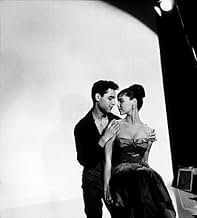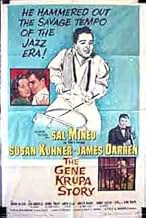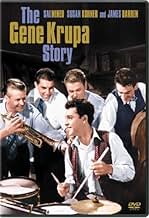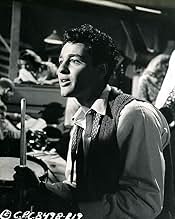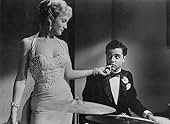Ajouter une intrigue dans votre langueBiopic of famous jazz drummer, Gene Krupa, who becomes a sensation but cannot handle success and life in the fast lane and ends-up broke, struggling with drugs and alcohol.Biopic of famous jazz drummer, Gene Krupa, who becomes a sensation but cannot handle success and life in the fast lane and ends-up broke, struggling with drugs and alcohol.Biopic of famous jazz drummer, Gene Krupa, who becomes a sensation but cannot handle success and life in the fast lane and ends-up broke, struggling with drugs and alcohol.
- Prix
- 1 victoire et 1 nomination au total
Stanley Adams
- Bar Owner
- (uncredited)
Marie Ardell
- Minor Role
- (uncredited)
Candy Barr
- Stripper
- (uncredited)
Arthur Berkeley
- Stagehand
- (uncredited)
John Bleifer
- Father
- (uncredited)
Avis en vedette
Not historially accurate, but a great portrayal by Sal Mineo. He worked with Krupa for about 2 years before filming began. The only real flaw is that the music is a 1950's version of 1930's swing/jazz, and none of Krupa's hits of the 40's were really included. Nonetheless, the music is very good, with Mineo mimicing extremely accurately Krups's off screen drumming.
Sal Mineo was a real so-so actor. Apart from his fresh, young looks, sweet face, deep eyes and athletic build, he was not more than a third rate version of some James Dean or even Elvis, who was a mediocre actor, too. Here, Sal tries to take on life of great late drummer (my personal musical favorite in jazz) Gane Krupa. Did Sal succeed? Nay, he did not. Gene was an affable, lovable, open-hearted man of integrity and skill. Sal is OK but not deeply convincing. Instead, he looks more like a talented, but hapless, selfish, spoiled man of some unripe masculinity. One thing is great for sure - Sal really knew how to play them drums well. Yes, real Gene Krupa recorded all the drum parts for the movie, but Sal mimicked them all with such a thrilling precision and skill that I, as a drummer myself, was awed. The love line is nothing more than a very typical 50's Hollywood kitsch palette of clichés and banality. Well, one more great thing is an outstanding jazz soundtrack with all the greats included. The film could have become a bigger and better thing, but all is jammed and packed in 100 minutes and the aftertaste is somewhat sour and bitter. Gene deserved a better impersonator, in fact. And the movie a better script.
10whpratt1
Always enjoy listening to the great talent of Gene Krupa along with Buddy Rich. This is a film dealing with Krupa's childhood which dealt with his becoming a Priest and then a world famous drummer in the 1940's. Sal Mineo, (Gene Krupa),"Rebel Without a Cause",'55, did a great job of trying to imitate Gene on the drums along with Susan Kohner,(Ethel Maguire),"Freud",'62, who was his girlfriend and loyal supporter through out this picture. This film portrays the good and bad times of Gene Krupa and most of his bad times were caused by a frustrating childhood and a great love of his mother and father, who both demanded too much from their son. Great Class film along with great musicians.
I recall seeing this as a teenager and thinking it was great. As a 75 year old retired musician who lives music history, it annoyed me.
When a producer allows a song from 1940 (Let There be Love) to be inserted into a scene from the mid20s I call foul. The early scene with Krupa jamming with the Austin High Gang is arranged in the style of a 1960s Las Vegas showband. The scene with Red Nichols is equally absurd with bop-based jazz chorus.
Then comes "Cherokee" (written in 1938) played at a tempo and style at least 20 years in the future. Then comes the cocktail party which looks like a scene from Playboy After Hours. No attempt is made to costume authenticity. The band jamming sounds like Sam Butera on speed.
Later a beautiful version of "Memories of You" appears, but sung in a style si,liar to Julie London. Not until "Back Home in Indiana" does the music come close to stylistically historical accuracy. But then the overdone "everybody has a drum" schtick even ruins that. "Hawaiian War Chant" provides some redemption, but not enough to change my sum total reaction to the film - meh!
As others have mentioned, the film was obviously marketed to teens. Unfortunately anyone who knows anything about Krupa, or the swing era, will likely find it annoying.
When a producer allows a song from 1940 (Let There be Love) to be inserted into a scene from the mid20s I call foul. The early scene with Krupa jamming with the Austin High Gang is arranged in the style of a 1960s Las Vegas showband. The scene with Red Nichols is equally absurd with bop-based jazz chorus.
Then comes "Cherokee" (written in 1938) played at a tempo and style at least 20 years in the future. Then comes the cocktail party which looks like a scene from Playboy After Hours. No attempt is made to costume authenticity. The band jamming sounds like Sam Butera on speed.
Later a beautiful version of "Memories of You" appears, but sung in a style si,liar to Julie London. Not until "Back Home in Indiana" does the music come close to stylistically historical accuracy. But then the overdone "everybody has a drum" schtick even ruins that. "Hawaiian War Chant" provides some redemption, but not enough to change my sum total reaction to the film - meh!
As others have mentioned, the film was obviously marketed to teens. Unfortunately anyone who knows anything about Krupa, or the swing era, will likely find it annoying.
Imagine that it is 1970 and they have just released "The Frank Sinatra Story" with then 20 year-old David Cassidy playing the Italian crooner from ages 17 through 47. If that sounds weird imagine that the production designer on the film never shows up and they film it as if everything from 1935 to 1965 looks (and everyone talks) like it is set in 1970. Finally imagine that to preserve the 1970's look, all the action takes place inside, with one short scene on an indoor sound stage with fake grass and trees.
That is essentially "The Gene Krupa Story", with bobby soxer heartthrob Sal Mineo replacing Cassidy, Krupa replacing Sinatra, and the look of 1959 replacing 1970. Mineo was the Cassidy of his generation, with about the same level of acting talent but harder working and more willing to take direction.
Like the imagined "Cassidy as Sinatra" film, the idea was to expand the target audience by including someone who would attract teen and pre-teen girls. In this "The Gene Krupa Story" was successful and the film had good box office. The downside was that big band fans generally considered the whole production laughable. My father was a huge Krupa fan and he hated this film with an unprecedented passion. In part for the cheap production design and in part because of Mineo and the reasons for his casting, but largely because of the many factual omissions and distortions. To him the only saving grace was that they used Krupa's actual drumming, to which Mineo is generally in sync although there are times when he is beating a tom and the sound is that of a cymbal.
Like most Hollywood bio movies ("The Lou Gerhig Story", "The Al Jolson Story", etc.) Krupa's mother was violently opposed to her son's ambitions, in this case she and her husband want him to be a priest. But he leaves the seminary to set out for New York with Eddie Sirota (James Darren) and Eddie's composer girlfriend, Ethel (Susan Kohner). After a rough three months Ethel is forced to take a job as a telephone operator and her romantic interest switches to Gene.
Gene's career takes off and he begins running with a fast crowd of 1930's musicians (who sound strangely like a Maynard G. Kreb's take on the 1950's beat scene). A jazz singer named Dorissa Dinell (Susan Oliver) connects him with some dope dealers and the film gets a lot like "Reefer Madness" (but with a 1959 setting). Which may account for a surreal montage of newspaper headlines chronicling his rise to national fame and his fall in a drug bust. There is even an "I told you so" phone call from mom. This has ramifications beyond Krupa as the entire jazz world is outed as dope fiends and corrupter of America's youth. When the chips are down, Dorissa bails on Gene with the classic exit line: "Now if you'll excuse me, I've got a town I'd better get out of." Gene is reduced to playing in strip clubs with other beatnik musicians wearing dark glasses. When it seems like he can't go on another day Ethel re- enters his life and things begin to break his way once again.
For the aging sequences Mineo could draw upon the example James Dean, who he worked with in both "Rebel Without a Cause" and "Giant". Dean was faced with the same challenge in "Giant" and Mineo's attempt here is clearly superior. So much so that what could have been the film's biggest liability is actually a strength. And Mineo successfully mimics Krupa distinctive drumming style and facial expressions, details that he worked on with Krupa himself. There are seven drum solo set pieces, mostly medium shots that capture the spirit if not the actual magic of a Krupa performance.
Susan Kohner shows considerable range in two of her 1959 films, this one and "Imitation of Life". Here she will remind you of Eva Marie Saint's "On the Waterfront" character, a considerable contrast with the overwrought racially conflicted daughter she played in the other film. The likable James Darren (later to star in television's "The Time Tunnel") is a better singer than an actor. His scenes with Mineo are pretty awful, certainly the film's worst moments, and the fault does not lie with Mineo who tends to play up or down to the level of whoever he shares a scene. The hard working Mineo simply did not have enough talent or training to salvage a scene gone bad and really needed to be surrounded by a strong cast to help him sell his characterizations. Susan Oliver ("Butterfield 8") gets the best role and has a lot of fun with her character, benefiting from having almost all of the film's good lines. "Snow me again, junior, because I didn't quite get your drift." When I see her in a film I am always reminded of her classic guest-staring appearance as the sizzlingly hot female prisoner Barney and Andy have to cope with in episode 4-18 of "The Andy Griffith Show".
Then again, what do I know? I'm only a child.
That is essentially "The Gene Krupa Story", with bobby soxer heartthrob Sal Mineo replacing Cassidy, Krupa replacing Sinatra, and the look of 1959 replacing 1970. Mineo was the Cassidy of his generation, with about the same level of acting talent but harder working and more willing to take direction.
Like the imagined "Cassidy as Sinatra" film, the idea was to expand the target audience by including someone who would attract teen and pre-teen girls. In this "The Gene Krupa Story" was successful and the film had good box office. The downside was that big band fans generally considered the whole production laughable. My father was a huge Krupa fan and he hated this film with an unprecedented passion. In part for the cheap production design and in part because of Mineo and the reasons for his casting, but largely because of the many factual omissions and distortions. To him the only saving grace was that they used Krupa's actual drumming, to which Mineo is generally in sync although there are times when he is beating a tom and the sound is that of a cymbal.
Like most Hollywood bio movies ("The Lou Gerhig Story", "The Al Jolson Story", etc.) Krupa's mother was violently opposed to her son's ambitions, in this case she and her husband want him to be a priest. But he leaves the seminary to set out for New York with Eddie Sirota (James Darren) and Eddie's composer girlfriend, Ethel (Susan Kohner). After a rough three months Ethel is forced to take a job as a telephone operator and her romantic interest switches to Gene.
Gene's career takes off and he begins running with a fast crowd of 1930's musicians (who sound strangely like a Maynard G. Kreb's take on the 1950's beat scene). A jazz singer named Dorissa Dinell (Susan Oliver) connects him with some dope dealers and the film gets a lot like "Reefer Madness" (but with a 1959 setting). Which may account for a surreal montage of newspaper headlines chronicling his rise to national fame and his fall in a drug bust. There is even an "I told you so" phone call from mom. This has ramifications beyond Krupa as the entire jazz world is outed as dope fiends and corrupter of America's youth. When the chips are down, Dorissa bails on Gene with the classic exit line: "Now if you'll excuse me, I've got a town I'd better get out of." Gene is reduced to playing in strip clubs with other beatnik musicians wearing dark glasses. When it seems like he can't go on another day Ethel re- enters his life and things begin to break his way once again.
For the aging sequences Mineo could draw upon the example James Dean, who he worked with in both "Rebel Without a Cause" and "Giant". Dean was faced with the same challenge in "Giant" and Mineo's attempt here is clearly superior. So much so that what could have been the film's biggest liability is actually a strength. And Mineo successfully mimics Krupa distinctive drumming style and facial expressions, details that he worked on with Krupa himself. There are seven drum solo set pieces, mostly medium shots that capture the spirit if not the actual magic of a Krupa performance.
Susan Kohner shows considerable range in two of her 1959 films, this one and "Imitation of Life". Here she will remind you of Eva Marie Saint's "On the Waterfront" character, a considerable contrast with the overwrought racially conflicted daughter she played in the other film. The likable James Darren (later to star in television's "The Time Tunnel") is a better singer than an actor. His scenes with Mineo are pretty awful, certainly the film's worst moments, and the fault does not lie with Mineo who tends to play up or down to the level of whoever he shares a scene. The hard working Mineo simply did not have enough talent or training to salvage a scene gone bad and really needed to be surrounded by a strong cast to help him sell his characterizations. Susan Oliver ("Butterfield 8") gets the best role and has a lot of fun with her character, benefiting from having almost all of the film's good lines. "Snow me again, junior, because I didn't quite get your drift." When I see her in a film I am always reminded of her classic guest-staring appearance as the sizzlingly hot female prisoner Barney and Andy have to cope with in episode 4-18 of "The Andy Griffith Show".
Then again, what do I know? I'm only a child.
Le saviez-vous
- AnecdotesWhen the film opened in Krupa's hometown of Chicago at the Schiller Theatre on January 15, 1960 both Gene Krupa and Sal Mineo were on hand to greet the public and sign "fan fotos."
- GaffesWhen we see Gene at his penthouse on Central Park, at the party one of the guests is Bix Beiderbecke. Bix died in 1931 and only ever played with Gene Krupa in Chicago. By the time Krupa made it in New York, Bix had already died.
- Citations
Gene Krupa: Who's the snake charmer?
Dorissa Dinell: Anita O'Day. Not bad - if you like talent.
- ConnexionsFeatured in Police Story: The Broken Badge (1978)
Meilleurs choix
Connectez-vous pour évaluer et surveiller les recommandations personnalisées
Détails
- Durée1 heure 41 minutes
- Couleur
- Rapport de forme
- 1.66 : 1
Contribuer à cette page
Suggérer une modification ou ajouter du contenu manquant

Lacune principale
By what name was The Gene Krupa Story (1959) officially released in India in English?
Répondre


